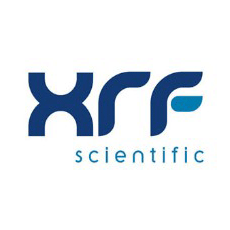X-ray fluorescence (XRF) analysis is a sensitive technique that can be used to observe the elemental composition and concentration of samples in a non-destructive manner. However, samples being analyzed by XRF must be carefully prepared to obtain actionable and accurate data for any application. For example, granulated powders may exhibit surface area irregularities that can introduce errors to analytical processes. To avoid these issues as well as acquire better insights into homogenous XRF reactions, researchers will typically prepare samples with glass bead machines.
A glass bead machine uses borate fusion to dissolve oxidized solid sample particles in a flux mixture at temperatures of up to 1250 °C (2192 °F) through either gas or electric heat sources, depending upon the specified application. The melted mixture is then cast into a mold and cooled to produce seamless sample beads that will be used for the XRF analysis.
XRF Scientific provides both gas and electric glass bead machines for XRF sample preparation.
.jpg)
Gas Glass Bead Machine
The Phoenix II is XRF Scientific’s benchmark for gas-powered glass bead machine standards. This machine utilizes an adaptive burner to heat fusion mixtures in a platinum crucible to reach a maximum continuous temperature that can be as high as 1250 °C. The Phoenix II is also equipped with an intuitive user-interface that enables researchers to modify flow parameters and control the temperature through a fusion cycle.
All programmable parameters for the Phoenix II glass bead machine include:
- Preheating and heating temperatures and durations
- Pouring angle and speed
- Dual-stage cooling
The Phoenix II utilizes natural or propane gas to heat platinum crucibles, all the while maintaining an exceptional throughput that can be as high as 30 beads per hour. The only apparent disadvantage to this glass bead machine is the perception that gas heating sources are not as safe or secure as electric heaters; however, the Phoenix II is regarded as the safest gas fusion machine that is currently available on the market, as it meets the highest possible gas shut-off standards. As a result of its exceptional properties, the Phoenix II glass bead machines have been installed in thousands of different facilities around the world.
Electric Glass Bead Machine
The xrFuse range from XRF Scientific includes a selection of electric glass bead machines of varying specifications that can be suitable for multiple different applications. For example, the xrFuse 1 is a compact electric fusion machine that has a maximum operating temperature that can reach as high as 1200 °C (2192 °F). Additionally, this machine has a quick change-out option and is specialized for lower throughput applications. On the other hand, the xrFuse 6 is able to reach a higher maximum operating temperature of 1250 °C and can also match the Phoenix II glass bead machine in terms of its high throughput and usability. The only potential drawback of the xrFuse 6 appears to be that electricity glass bead machines have higher electricity demands as compared to gas-powered fusion equipment.
Increased fusion capabilities of these types of machinery have improved the capacities of both gas-powered and electric glass bead machines. As a result, fusion machines have been shown to drastically improve the realistic options available to researchers studying XRF analysis. Despite the apparent differences that exist between gas and electric powered fusion machines, it has been shown that the benefits and drawbacks of these machines are essentially application-specific.
Glass Bead Machines from XRF Scientific
XRF Scientific is a leading supplier of both XRF and ICP analysis instrumentation and equipment. This company provides researchers with high-precision glass bead machines for laboratory and research facilities across the world.

This information has been sourced, reviewed and adapted from materials provided by XRF Scientific.
For more information on this source, please visit XRF Scientific.